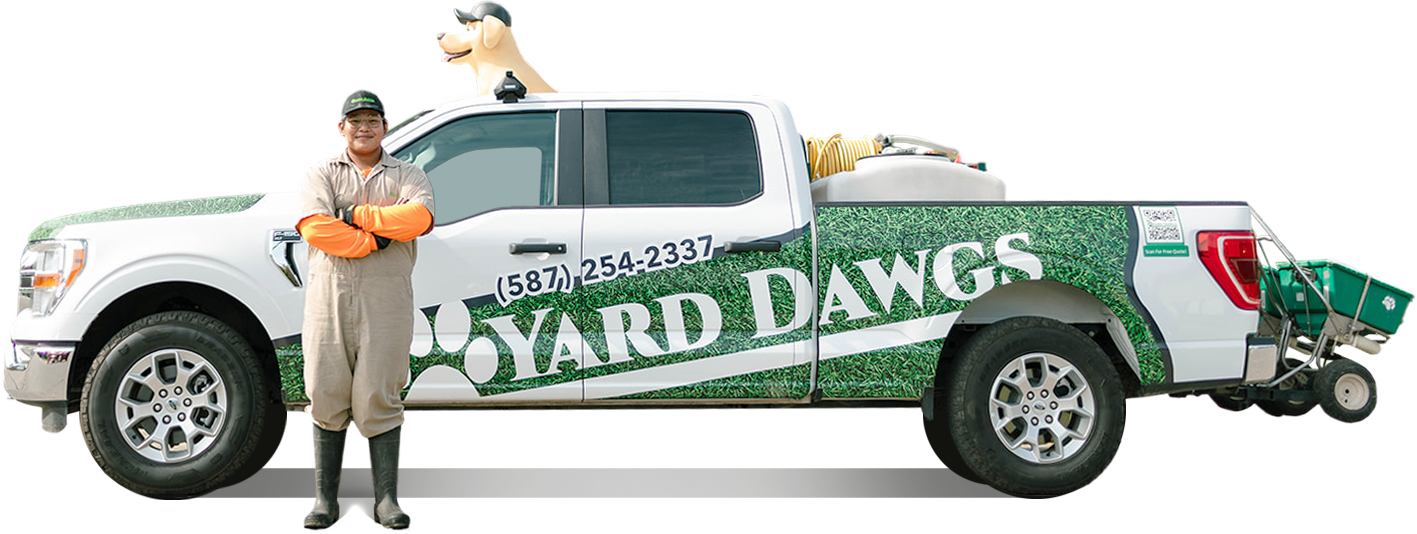It’s April, you look outside your window and see your lawn, and the sight is less than impressive. It’s brown and yellow and you see little hope of revival. Perhaps, you've agreed to host the first barbecue of the season and you need your lawn at it's top form. Regardless of what you’ve been told about power raking, you see it as the best bet when it comes to removing all that dead grass. After all, you want to restore your lawn to its optimal form and vitality. However, power raking lawn is a highly detrimental practice. It causes damage to your lawn’s growth when your goal should be enhancement. Trust us, we’ve been on both sides of the issue.

Power raking is a service we used to perform at Yard Dawgs. We honestly believe we were doing it more than any other company in Calgary – 600 to 800 in one month, 20 per day. Fortunately, after research we realized the detrimental effects of power raking lawn and chose to forgo this service in order to better care for the lawns of our clients. It leaves your lawn in worse condition, and weed prone.
What Is Power Raking?
A lawn power rake is a machine that has tines which rake your lawn as it’s pushed over the grass at several dozen times a second. As you go over the lawn, loads of dead grass will start to pile up. Pounds of thatch will crop up, and after you’re finished, your lawn will look like it got quite a nice haircut. However, at Yard Dawgs we don’t recommend this service. There are many short-term benefits, but in the long run it’s detrimental for your grass.

What Does a Power Rake Do?
When you’re finished power raking, you’ve removed a lot of winter build up, but you’ve also removed healthy grass, healthy thatch, and the crown of your grass. To fully understand the detrimental effects of power raking, you’ll need to understand your grass’ structure. To avoid insulting the intelligence of anyone reading this, I’ll waive the explanation of what a grass blade is.
- Crown: The crown of your grass is the whitish part at the base of each blade. It connects the roots and the shoots and is the point where grass growth originates. It’s the health, the heart, the mothership of your grass.
- Thatch: Thatch is the layer between the actively growing grass and the soil beneath. It’s a normal component of grass and can increase the resiliency of your grass to foot traffic. It develops more readily on high-maintenance lawns than on low-maintenance lawns.
The grass roots grow through the thatch to get into the soil for nutrients and water. The soil also stores nutrients for the grass. Roots will extend their reach into the soil to maximize water absorption. To get to the thatch the power rake needs to go through the crown of your grass. If the roots of the grass are killed, the lawn can survive. If the blades die, the grass will survive. If the crown (the heart) of the grass is killed, the grass will not resurrect – it’s dead.
Power Rake vs Dethatcher
A power dethatcher is another tool used to remove thatch, but it is often less aggressive than a power rake. Unlike a power rake, which digs deeper into the lawn and can harm the crown of your grass, a dethatcher works more gently, primarily focusing on pulling up thatch without disrupting the roots as much. The dethatcher is more effective for maintaining lawn health without causing long-term damage.
After The Winter Months
.png?width=725&name=Blog%20Image%20Sizing%20(1).png)
Because of how frigid Canadian winters are, your grass becomes dormant. In reality it’s hibernating. When it’s too cold for it to grow – it goes into a state of dormancy. When the snow finally melts and your grass is visible again, it’s often a pathetic sight. The yellow, brown grass that starts to crop up, is not in fact dead. Often homeowners become anxious when they see the effects of winter in the state of their grass. Your lawn will return to it’s green and lush shape with time. When the snow finally melts in April or May your grass just needs a chance to spruce up.
Raking Lawn in Spring
Spring is the perfect time to rake your lawn, especially after the long, harsh winter months. As your grass begins to emerge from dormancy, the first step to lawn care should be raking. This helps to remove any dead grass, leaves, or debris, allowing the grass to receive nutrients, sunlight, and air. Proper raking in spring ensures the healthy regrowth of your lawn and reduces the chances of fungal diseases.
Thatch
One of the best natural weed barriers is the thatch. Weeds have a hard time germinating the soil and growing through the thatch. Sunlight doesn't breakthrough and grass receives water before the weeds in your lawn can. Everything is a competition; every nutrient is competed for, and you want your grass to have the best chance of winning. When there is too much thatch it can choke your lawn. A thick layer can harbour pests or diseases. It limits the ability of oxygen and water to reach the soil. As well, with a solid layer of thatch mower scalping can occur. The mower wheels will sink down into the thatch, then the height of the mower cut lowers as well. This is detrimental most prominently because the crowns of your grass will also be elevated above the thatch layer, making it most likely they will be cut in the process.
The best defense against thatch build up, and the middle ground against that and power raking, is hand raking.
- Hand Raking: lightly raking your lawn will get the thatch up, which isn’t a difficult task. There’s no need to break a sweat, because when you’re raking with all your strength, you’re more than likely killing crowns at the same rate your removing thatch.
The least expensive option when it comes to dethatching your lawn is purchasing a manual thatch rake. These are designed to pull the thatch out of your grass without damage to the healthy grass. Be cautious not to aggressively work the tines into your grass because you risk damaging your lawn and it’s a waste of time. It's always best to consult your lawn care company when it comes to caring for your yard. We put a substantial amount of research into all our services. A professional company can best advise you on how to proceed before making a purchase or decision that will ultimately be detrimental for your grass' health.
Power Raking vs Aeration
While power raking focuses on removing thatch and dead grass, aeration helps improve soil compaction and allows air, water, and nutrients to reach the roots of your grass. Aeration involves pulling small plugs of soil from your lawn, which reduces soil compaction and helps with thatch decomposition. Unlike power raking, aeration doesn’t disturb the crown of your grass and is better suited for long-term lawn health.
De-Thatching
You’ve now gone ahead and de-thatched your lawn, be it by power raking or a hand rake. If by power rake, we’ve outlined the damage it can cause, but perhaps you were a bit too enthusiastic with hand raking the thatch and you’ve cause root damage in different areas of your lawn. The good news is the damage is most certainly fixable.
Repairing Power Raking Lawn Damage
- Cut your grass shorter than normal and bag the grass clippings
- Rake a thin layer of soil over your lawn to help the grass seed settle in (0.25-inch of soil)
- Apply the grass seed to your lawn
- Your new grass requires constant care and maintenance. It’s important you water your lawn so the seedlings reach the height of the rest of your grass
To completely combat the damage of power raking, a lawn care company will be able to properly apply fertilizer and weed control. If you’ve ripped up your entire lawn’s layer of thatch, weeds will move in quickly without any competition, so you’ll need to be able to fight the early onset of weeds.
Instead of dethatching your grass, it’s best to aerate your lawn in early fall. By removing soil cores, you’re allowing your lawn to breathe and diminishing compaction. But the most prominent added benefit to aeration, is the way it hastens thatch decomposition, improving water, nutrient, and oxygen movement within your soil. The cores of soil should be left on your lawn to decompose naturally. When the soil and thatch intermingle, it provides your lawn with beneficial nutrients.
In Summary
A power rake is an aggressive tool that, when used, will rip through the grass on your lawn. When you power rake and tear out the crown of your grass, not only does your grass die, but the weeds in your lawn also now have the chance to take over. You’ve removed enough of the thatch for them to break through and a fair amount of your grass would have been killed in the process. Unless a homeowner has done nothing more to their lawn than mowing for over 5 years, power raking is not the service you want performed on your lawn. You want your grass to have the best chance of survival. All caveats say before power raking, you must be prepared to overseed afterwards. If power raking causes such a high degree of damage, and seeding is needed to facilitate recovery, why would it be recommended in the first place?
To best ensure your lawn gets the nutrition and care it needs, only do a light hand rake, and leave the rest up to the professionals. We want to see your lawn as green and weed free as possible, and therefore, for your sake as a homeowner, we advise against power raking.







.png)









